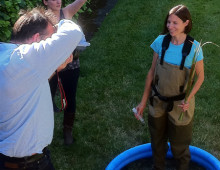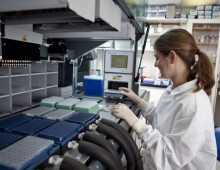Inside the guts of many animals, microbes break down the plant fibers ingested as part of their diet. These microbes are of interest to bioenergy researchers who want to learn from nature and apply these cellulosic degradation capabilities toward biofuel production. To this end, at the JGI, several sequencing projects have focused on the microbial…
Genomic analysis of self-fertilizing fungi
Filamentous fungi help decay plant material, a process which has applications for producing biofuels and other products. The model organism for filamentous fungi is Neurospora tetrasperma. Neurospora tetrasperma rosette (Image by Namboori B. Raju, Stanford University) Selected for the DOE JGI’s 2007 Community Sequencing Program, the fungi is of interest to researchers such as studying…
DOE JGI’s Tringe in PopSci’s Brilliant 10
Susannah Green Tringe of the DOE Joint Genome Institute (DOE JGI) has been named one of 2011’s “Brilliant 10,” the annual list compiled by Popular Science magazine of top young researchers. In adding her name to the list, which appears in the October issue, the magazine recognized her $2.5 million grant from the DOE Early…
Soil biocrust microbial genome
One of the DOE JGI’s 2011 Community Sequencing Program projects involves studying biological soil crusts to understand their role in the global carbon cycle. Found in arid lands which make up nearly half of the planet’s total land mass, communities of lichens, mosses and cyanobacteria use soil particles to form biocrusts less than half an…
Tringe on Popular Science’s “Brilliant 10” List
WALNUT CREEK, Calif.—Susannah Green Tringe of the DOE Joint Genome Institute (DOE JGI) has been named one of 2011’s “Brilliant 10,” the annual list compiled by Popular Science magazine of top young researchers. In adding her name to the list, which appears in the October issue, the magazine recognized her $2.5 million grant from the…
High-temperature enzymes for biomass breakdown
To overcome the challenge of breaking down cellulosic biomass for commercial biofuel production, which involves the application of high temperatures, a team of researchers including DOE JGI’s Martin Allgaier, now at the Leibniz-Institute of Freshwater Ecology and Inland Fisheries in Germany, and Phil Hugenholtz, now director of the Australian Centre for Ecogenomics at the University…
Dry rot (Serpula) genome project in BasqueResearch.com
Science journal has published research work on the sequence of the genome of the Serpula lacrymans fungus and in which the Public University of Navarre (UPNA) lecturers Gerardo Pisabarro de Lucas and José Antonio Oguiza Tomé, professor and senior lecturer in Microbiology respectively, participated. The research, largely funded by the US Department of Energy through…
Dark ocean project in Climate Action
To understand the world’s climate, we must understand how the 70% of the Earths surface that is covered with water behaves. Very little is known about the processes below 200m, or the area where photosynthesis is not possible due to the lack of light penetration. Scientists from the U.S. Department of Energy Joint Genome Institute…
Capturing carbon in the dark ocean
Using single cell genomics, researchers identified bacteria in the “twilight zone” that are involved in capturing carbon.
Up from the Depths: How Bacteria Capture Carbon in the “Twilight Zone”
WALNUT CREEK, Calif.—Understanding the flow and processing of carbon in the world’s oceans, which cover 70 percent of Earth’s surface, is central to understanding global climate cycles, with many questions remaining unanswered. Between 200 and 1,000 meters below the ocean surface exists a “twilight zone” where insufficient sunlight penetrates for microorganisms to perform photosynthesis. Despite…


